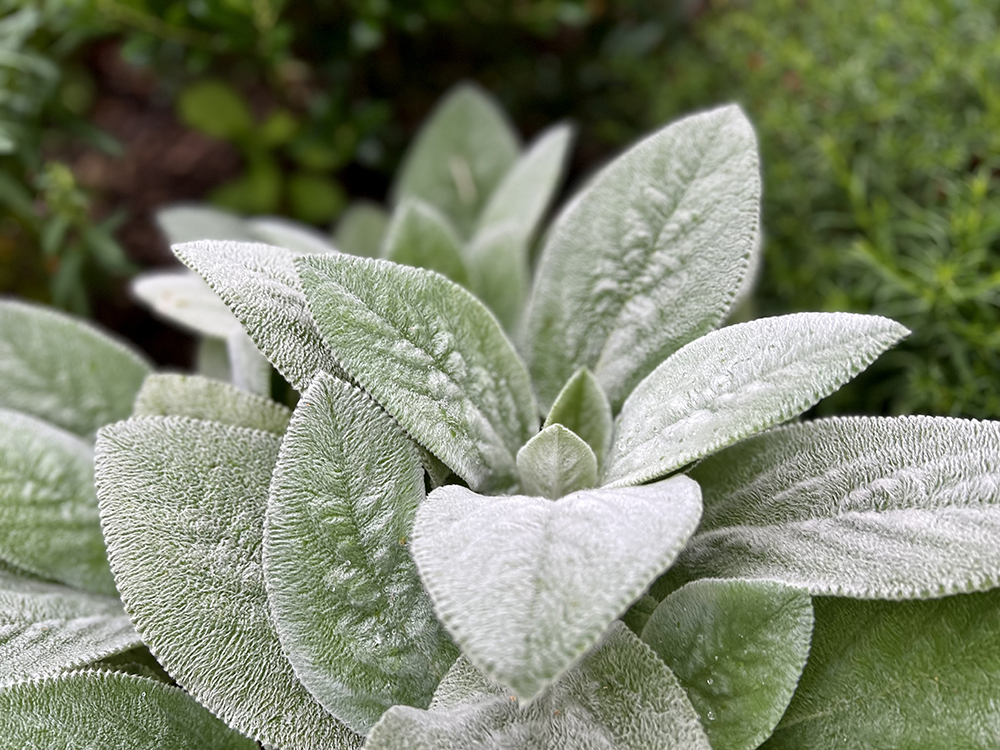
Fallon Henry, ASLA
Landscape ArchitectChildren love to explore. Whether that's at a park specifically designed for them or while they are tagging along to an outdoor space with parents, kids find features of play anywhere. Plantings within areas frequented by children can add an element of play, or they can create hazards cities would rather avoid. When designing outdoor spaces, one should always consider which guests are expected to visit there. When the target audience or even the occasional visitor includes children, landscape architects must factor this into their design criteria, specifically the plant material.
Children are incredibly imaginative; touching lamb’s ear may remind them of their favorite stuffed animal, while investigating the hummingbirds or butterflies invited to the butterfly bush may pique their sense of wonder. A shady arch of trees could be a playhouse. Vines can be twirled into crowns. Flowers become a gift.

Lamb's Ear (Stachys byzantine) is safe to use in areas frequented by children.
As a mother, I can speak from personal experience. My children once found some amazing “swords” to play with while at a child-focused area and suffered intense skin irritation from a Lords and Ladies plant (these contain oxalate crystals prone to causing a burning sensation to skin). Did it look colorful, bright, and inviting? Yes. Should it have been in an area where kids play daily? No.
Hazards aren’t always what adults think. Kids generally avoid thorny plants, but enticing flowers may not be safe for them. Hydrangeas are poisonous, and daffodils may tempt a child to pick them, but they can present a mild irritant. Foxtail grass isn’t dangerous because of toxicity; rather, their barbed seed awns are dangerous if inhaled. Poppies and oleanders are toxic if ingested. Some berries are safely edible and may invite exploring, but unless you have ensured they are not toxic, avoid adding them to a space for children.
Plants suitable for child play areas
| Common Name | Scientific Name | Sunlight Preference | Hardiness Zone |
|---|---|---|---|
| Crepe Myrtle | Lagerstroemia | Full sun | 7-10 |
| Japanese Snowball Viburnum | Viburnum plicatum | Full sun, part shade | 5-8 |
| English Lavender | Lavandula angustifolia | Full sun | 5-10 |
| Lamb's Ear | Stachys byzantina | Full sun, part shade | 4-8 |
| Zinnia | Zinnia | Full sun | 3-10 |
| Spiraea | Spiraea | Full sun | 4-8 |
| Weigela | Weigela | Full sun | 4-8 |
| Coral Bells | Heuchera | Full sun, part shade | 4-9 |
| Astilbe | Astilbe chinensis | Part shade, full shade | 3-8 |
| Purple Coneflower | Echinacea | Full sun, part shade | 4-9 |
| Butterfly Bush | Buddleja | Full sun | 5-9 |
| Verbena | Verbena | Full sun | 7-11 |
| Silver Sage | Salvia argentea | Full sun, part shade | 5-9 |
| Snapdragons | Antirrhinum | Full sun, part shade | 7-11 |
Plants to avoid in child play areas
| Common Name | Scientific Name | Sunlight Preference | Hardiness Zone |
|---|---|---|---|
| Begonia | Begonia | Shade, partial shade | 9 -10 |
| Holly | Ilex aquifolium | Full sun, partial shade | 6-9 |
| Peonies | Paeonia | Full sun | 3-8 |
| Azaleas | Rhododendron | Full sun, partial shade | 6-9 |
| Oleander | Nerium oleander | Full sun, partial shade | 8-10 |
| Lantana | Lantana camara | Full sun | 7a-11a |
| Daffodil | Narcissus | Full sun, partial shade | 3-8 |
| Daphne | Daphne odora | Full sun, partial shade | 4-9 |
| Foxglove | Digitalis | Full sun, partial shade | 4-9 |
| Hydrangea | Hydrangea | Partial shade | 3-7 |
| Golden Rain Tree | Koelreuteria paniculata | Full sun | 5-9 |
Please note that these lists are not exhaustive. It is always a good idea to check poison control databases before adding plants to spaces for kids to ensure that they are non-toxic.
While there are many toxic plants to avoid in spaces children frequent, effective plant selection can make for a safe, child-inclusive environment that is beautiful and sustainable. When landscape architects prioritize interesting, safe plants, public spaces are more conducive to kids' imagination and play. With proper planning and preparation, safe plant selection can easily be incorporated into site development, and your next outdoor space can be a magical playground for children.